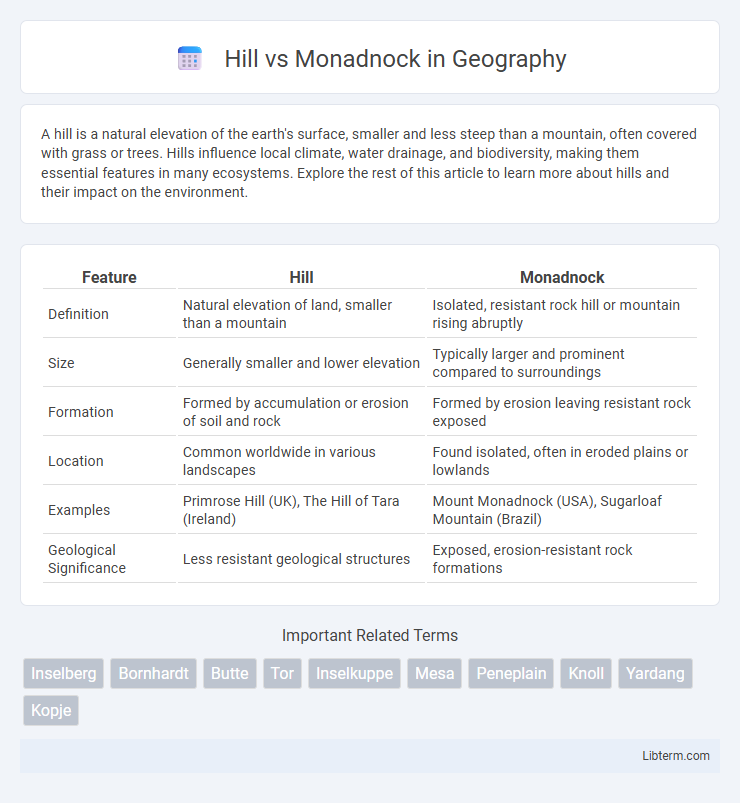A hill is a natural elevation of the earth's surface, smaller and less steep than a mountain, often covered with grass or trees. Hills influence local climate, water drainage, and biodiversity, making them essential features in many ecosystems. Explore the rest of this article to learn more about hills and their impact on the environment.
Table of Comparison
| Feature | Hill | Monadnock |
|---|---|---|
| Definition | Natural elevation of land, smaller than a mountain | Isolated, resistant rock hill or mountain rising abruptly |
| Size | Generally smaller and lower elevation | Typically larger and prominent compared to surroundings |
| Formation | Formed by accumulation or erosion of soil and rock | Formed by erosion leaving resistant rock exposed |
| Location | Common worldwide in various landscapes | Found isolated, often in eroded plains or lowlands |
| Examples | Primrose Hill (UK), The Hill of Tara (Ireland) | Mount Monadnock (USA), Sugarloaf Mountain (Brazil) |
| Geological Significance | Less resistant geological structures | Exposed, erosion-resistant rock formations |
Understanding the Definitions: Hill vs Monadnock
A hill is a naturally raised area of land with a rounded summit, generally lower and less steep than a mountain, often formed by erosion or geological uplift. A monadnock, also referred to as an inselberg, is an isolated hill or small mountain that rises abruptly from a gently sloping or virtually level surrounding plain, created by the erosion-resistant rock remaining after softer rock has eroded away. Understanding these definitions highlights that hills are common landscape features with varied origins, while monadnocks are specific geological formations characterized by their isolation and resistance to erosion.
Geological Formation of Hills
Hill formations typically arise from the gradual accumulation and erosion of sedimentary layers, resulting in rounded, modest elevations characterized by softer rock compositions. Monadnocks, in contrast, form as isolated, resistant rock outcrops that withstand extensive erosion, commonly composed of igneous or metamorphic rock such as granite or quartzite. The geological formation of Monadnocks involves the differential weathering of surrounding softer rocks, leaving these prominent hills standing as enduring geological features.
The Origin and Evolution of Monadnocks
Monadnocks originate from ancient geological processes where resistant rock formations withstood extensive erosion, resulting in isolated hills or mountains rising abruptly from surrounding plains. These landforms typically form through prolonged weathering that removes softer rock layers, leaving harder rock exposed, often composed of granite or quartzite. The term "monadnock" itself derives from Mount Monadnock in New Hampshire, serving as a classic example of such an erosional remnant shaped over millions of years.
Key Physical Characteristics: Hill Compared to Monadnock
Hills typically have lower elevations and gentler slopes compared to the prominent, isolated Monadnocks, which rise sharply above surrounding terrain. A hill's rounded summit contrasts with the often rugged and rocky peak of a Monadnock, formed from erosion-resistant rock. Hills generally cover broader areas while Monadnocks stand as singular geological features, making them distinct landmarks.
Global Examples of Famous Hills
Famous hills such as Arthur's Seat in Edinburgh, Scotland, exemplify iconic global examples of hills known for their distinctive geological features and cultural significance. Unlike their larger counterparts like Monadnock mountains, hills typically present lower elevations and gentle slopes, making sites like Devil's Tower in the USA notable outliers often classified differently despite their prominence. These renowned hills attract tourists and hikers worldwide, highlighting their role in local heritage, biodiversity, and outdoor recreation.
Notable Monadnocks Around the World
Notable monadnocks around the world include Japan's Mount Fuji, renowned for its isolated volcanic prominence, and Uluru in Australia, famous for its massive sandstone composition rising sharply from the surrounding plain. In the United States, Stone Mountain in Georgia stands out as a prominent granite dome, while in Nigeria, Zuma Rock is a striking monadnock known for its distinctive monolithic appearance. These natural formations serve as prime examples of monadnocks, which are isolated hills or mountains that have resisted erosion and remain prominent in their landscapes, contrasting with smaller, less isolated hills often referred to simply as hills.
Erosion’s Role: Shaping Hills and Monadnocks
Erosion plays a crucial role in shaping hills and monadnocks by selectively wearing away softer rock layers and leaving behind more resistant formations. Monadnocks, often composed of durable igneous or metamorphic rock, stand prominently as isolated hills due to differential erosion processes that remove surrounding softer sedimentary material. Over time, these erosional forces sculpt distinctive landscapes by exposing ancient underground rock masses, resulting in the characteristic prominent features of monadnocks compared to gentler, more eroded surrounding hills.
Ecological Significance and Biodiversity
Hill ecosystems exhibit distinct microhabitats supporting specialized flora and fauna, contributing to regional biodiversity through unique altitudinal gradients. Monadnock formations provide isolated ecological niches with endemic species and serve as critical refuges for wildlife amid surrounding landscapes. Both landforms play vital roles in maintaining ecological balance, fostering species diversity, and supporting complex habitat networks.
Cultural and Historical Importance
Hill and Monadnock hold distinct cultural and historical significance in New England's landscape. Mount Monadnock, often called one of the most frequently climbed mountains in the world, has inspired American writers like Ralph Waldo Emerson and Henry David Thoreau, symbolizing natural beauty and transcendentalist philosophy. Hill areas, while less famous, often feature indigenous historical sites and local folklore that reflect the deep-rooted connections of Native American tribes and early settlers to the land.
Hill vs Monadnock: Key Differences and Similarities
Hill vs Monadnock presents distinct geological formations where a hill is a natural elevation of the earth's surface typically less than 600 meters high, while a monadnock is an isolated rock hill or small mountain rising abruptly from a gently sloping or virtually level surrounding plain. Both share similarities in being prominent landscape features, but monadnocks stand out due to their resistance to erosion, often composed of harder rock types such as granite or quartzite. Understanding these key differences and similarities aids in geological mapping and environmental studies focusing on erosion patterns and landform evolution.
Hill Infographic

 libterm.com
libterm.com